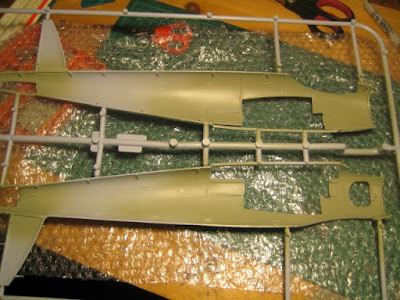The front axles, unfortunately, are well hidden under splash shields which also include the lower A-arms, so all the work done to showcase the front driven axles didn't contribute much. Nonetheless, I know it's there.

One issue with both kits was that the left side upper A-arm, which is molded in a piece with a chassis cross member and the right side A-arm, was cracked and bent. I suspect the piece got held up on ejection from the mold, and the bend stayed in the piece because it was probably still hot enough for the styrene to stay flexible. Getting it all to settle down required some cutting and filing.

Of course without a tie-rod joining them, it is possible to pose the two steering axles pointing in opposite directions ...

A shot of the cab sitting on the chassis give the overall effect. The ride height is unchanged from the standard kit. When you see one on the road, you'll notice how tall and narrow it is -- I'd be worried about it tipping if crossing a steep side-slope.

One challenge was getting 8 wheels to all ride at the same height, and it seems the rearmost axle sits a bit high and doesn't touch the ground, or perhaps the third axle sits too low and needs to sit further up into the chassis. This is unrelated to the slight upturn in the body seen at the back, which I may try to fix before final assembly.

The paint scheme will depend on what I am going to pair it with. The Honda F1 fits but the exhaust pipe needs to poke through the back window into the crew cab.

The Civic is a surprisingly poor fit. The Delica is claimed to be 1/24; the Civic is a Tamiya kit and I would have thought it was also 1/24. The model has a wheelbase of 98 mm; compared to data on Wikipedia (2388 mm), this works out to 1 in 24.4, not as far out as I would expect. Maybe the Delica is off scale; Wikipedia provides a range of wheelbases for this model, so it isn't really easy to compare.

The 510, being a Revell kit, is probably 1/25 which is why it is a borderline fit. If it were 1/24 it would probably be too big.


The S800, a Tamiya 1/24 kit, looks to be the best fit at this point, so yellow with red trim it is. Stay tuned for more!








































